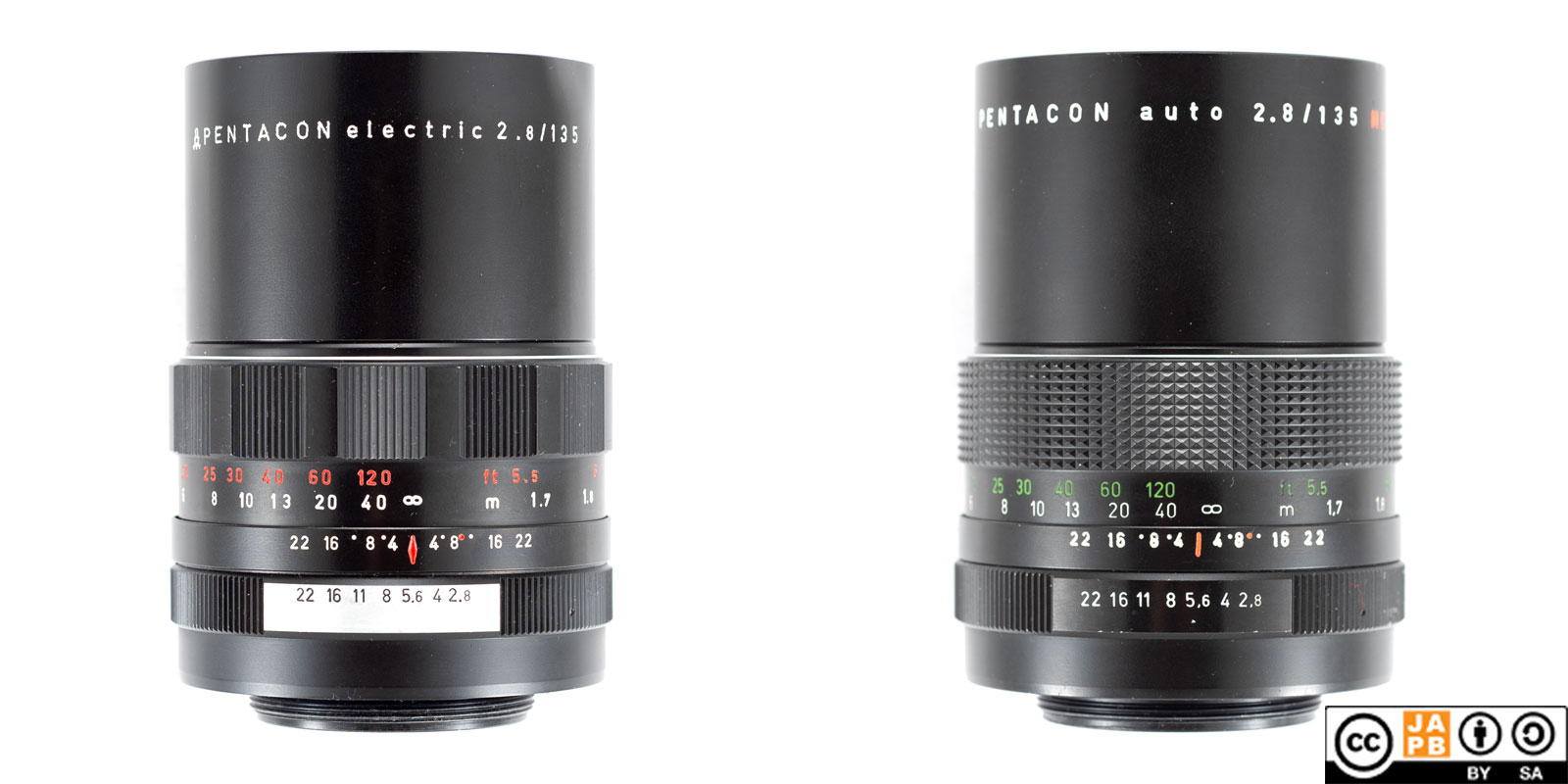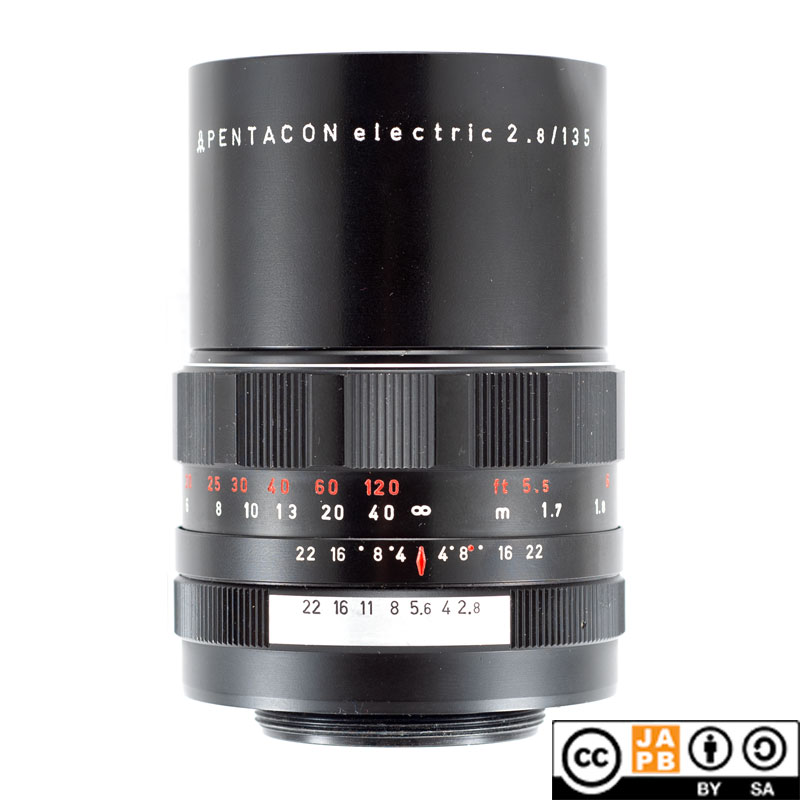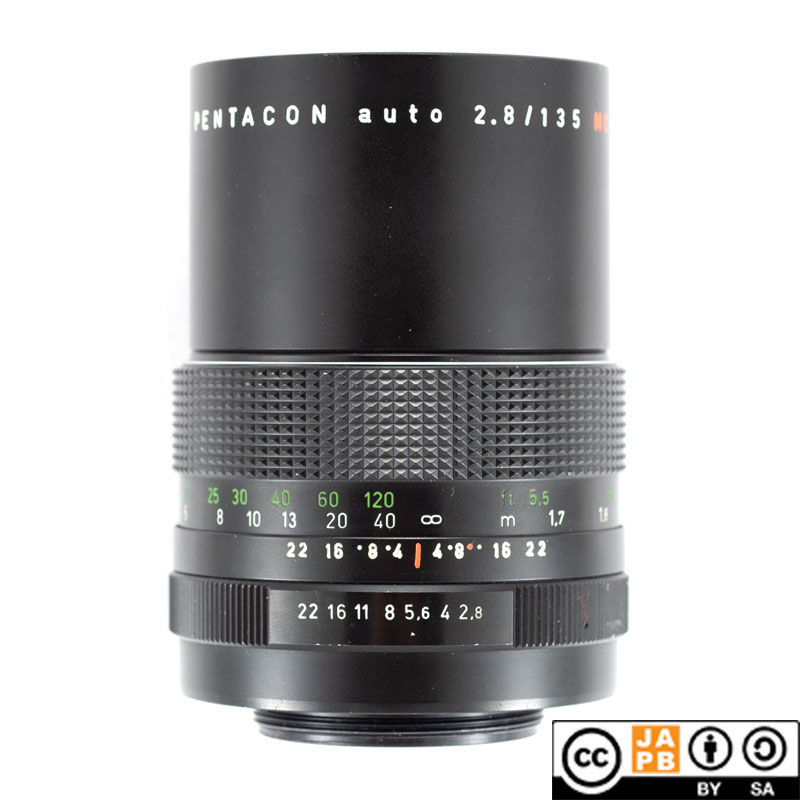Pekka Buttler, 11/2022 (Updated 08/2025)

Right: Pentacon auto 135 mm f/2.8 (3rd generation)
Specifications
The table below summarises the lens’ key specifications (measurements based on above pictured sample):
| Brand: | Pentacon | Lens name | (auto/electric) 2.8/135 (MC) |
| Focal length 1 | 135 mm | Angle-of-view 2 | 18 ° |
| Maximum Aperture | f/2.8 | In Production | 1970-1990 (all versions together) |
| Lens mounts | m42 (auto/electric) | Subfamily (if applicable) | –– |
| Length 3 | 89,1 mm | Diameter 4 | 65,6 mm |
| Filter ring diameter | 55 mm | Weight | 472 grams |
| Lens element count | 5 | Lens group count | 4 |
| Aperture blades (S/R/C) 5 | 6 S | Focus throw | 330 ° |
| Minimum focusing distance | 170 cms | Maximum magnification | 1:10.5 |
| Has manual aperture ring | YES | Has Manual focus ring | YES |
| Aperture mechanism type | Automatic | Aperture click stops 6 | 2.8•4•5.6•8•11•16•22 |
Further notes:
• As the differences between the electric and auto variants are small (especially for purposes of adapting), the auto and electric variants will be treated together. The Pentacon Prakticar 135/2.8 is covered separately [data sheet]
• The Pentacon 135/2.8 is the successor of the Meyer-Optik Görlitz Orestor 135/2.8.
• The Pentacon 135/2.8 was a well-liked lens that (together with the 50/1.8 and the 29/2.8) made up the ‘must-have’ trio of lenses. As a result, these lenses are available in plentiful numbers.
• All versions (and there are a lot of them, see below) of the Pentacon 135/2.8 auto/electric offer a built-in, extendable hood.
Versions
I’ll admit this is more than a bit complicated…
Firstly, Pentacon/Praktica cameras used two variants of the m42 mount,
• one was the classic m42 auto mount (pin at the bottom of the lens for stopping down). These lenses were generally indicated by the phrase ‘auto’ on the lens’ name ring.
• the other was Pentacon’s proprietary m42 variant which used electric contacts to communicate set aperture values to the camera, but still used the same m42 auto pin for stopping down. These lenses were generally indicated by the phrase ‘electric’ on the lens’ name ring.
Furthermore, the Pentacon 135/2.8 was offered throughout its life also as a preset-version (neither auto nor electric). While it was originally kept in the Pentacon lineup as a low-cost alternative, it is today relatively sought-after due to two aspects: Firstly, being a preset aperture, it uses a 15-blade aperture. Secondly, it can utilise Meyer’s patent mount adapter, making the lens usable on a range of mounts (m42, Exakta, Altix, Praktina).
Having been manufactured for ≈20 years, there are several ergonomically and outwardly different models of the Pentacon 135/2.8. Furthermore, Pentacon (as well as MOG before them) often tended to – when possible – use up parts stocks, meaning that one can also encounter hybrids.
• Early, 1st generation models would have a focus ring of milled metal ring and distance values in feet were in red. Typically this generation would also have some zebra-like cosmetically elements, e.g. that aperture values could be in black against a metallic background, but a lot of variation exists.

• 2nd generation models would be all-black, still have the feet indications in red, but the shape of the metal focusing ring would have changed from being lengthwise ribbed to a quadratic, checkered pattern.
• 3rd generation models would be very similar to 2nd generation models, but the color of the feet-indication would switch to green (See below for a 3th generation auto variant)

• a 4th generation made its appearance toward the end of the production run (from mid 80s onward) where the checkered pattern would change to a lengthwise elongated shape.

And just in case you thought this is not complicated enough, the first two generations were offered in both multicoated and non-multicoated variants (from the 3rd generation onwards, all copies seem to have been multicoated).
History of Pentacon
Pentacon – more precisely VEB Pentacon – was an East German state-owned camera and optics combinate that was very influential (also outside the East Bloc) from its inception until the demise of the East German people’s republic.
But Pentacon was not born out of thin air. Therefore any real appreciation of Pentacon – either as a camera maker or as an optics manufacturer – has to start with a back story. Read more in the JAPB company profile on Pentacon …
Adapting
This lens cannot be used natively on any current SLR or dSLRs. To use it in its native environment, you will need an m42-mount film body. Luckily there are a lot of those available and in working order.
Thanks to being a fully manual lens (manual aperture, manual focus), the lens can be adapted to all mirrorless cameras using a suitable adapter. Moreover, m42 lenses are so uncomplicated that a simple ‘dumb adapter’ will do the job perfectly. Further, due to the popularity of the m42 mount, special adapters (helicoid adapters, tilt/shift adapters) are readily available. Alternatively, one can choose to daisy-chain adapters (e.g. m42->Canon EF; Canon EF –> mirrorless) which also opens up a wide range of speed boosters .
Using m42 lenses on dSLRs can also be an easy option, depending on which dSLR.
• Canon EF has the shortest flange focal distance among full-frame dSLR’s and Canon’s wide range of dSLRs are able to mount m42 lenses perfectly, using a simple adapter ring.
• Minolta / Sony A dSLRs and Pentax dSLRs are likewise able to mount m42 lenses using a simple adapter ring.
• Nikon F dSLRs have a long flange focal distance, meaning that mounting either M42 or Exakta lenses needs an adapter that uses corrective optics to allow anything close to infinity focus.
Footnotes
- Focal length is (unless stated otherwise) given in absolute terms, and not in Full-frame equivalent. For an understanding of whether the lens is wide/tele, see ‘Angle-of-view’. ↩︎
- Picture angle is given in degrees (based on manufacturers’ specs) and concerns the diagonal picture angle. Rule of thumb:
> 90 ° ==> Ultra-wide-angle
70–90 ° ==> Wide-angle
50–70 ° ==> Moderate wide-angle
40–50 ° ==> ‘Standard’ or ‘normal’ lens
20–40 ° ==> Short tele lens
10-20 ° ==> Tele lens
5-10 ° ==> Long tele lens
< 5 ° ==> Ultra-tele lens ↩︎ - Length is given from the mount flange to the front of lens at infinity. ↩︎
- Diameter excludes protrusions such as rabbit ears or stop-down levers. ↩︎
- S=straight; R=rounded; C=(almost)circular at all apertures. ↩︎
- Numbers equal aperture values on aperture ring; • intermediate click; – no intermediate click. ↩︎